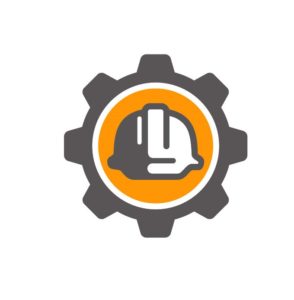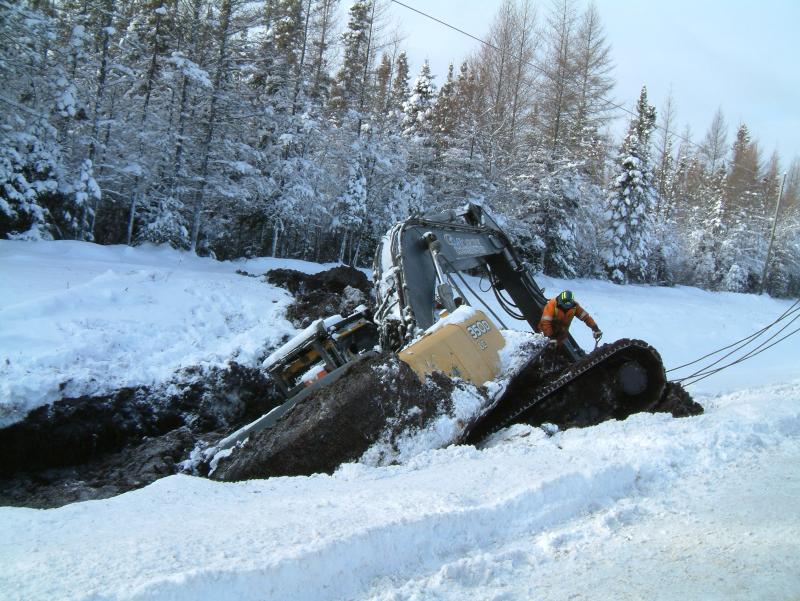
Another Incident!
My phone rang mid afternoon, there’s been an incident and I have to get over to site asap. An excavator had been travelling down a ROW and the operator had unknowingly walked onto a snow covered beaver pond and broke through the ice. He was able to get out of the machine but we now had to retrieve the excavator from four feet of water.
In this incident, to save time, the crewmember was instructed to walk the excavator from the active site to the location they would be at the next morning. The individual was new to the company and as such was following instructions as best he could, from whoever on the crew.
The foreman told him to walk down the ROW, which had a winter road built on the side of a new transmission line, sounds easy enough. What could possibly go wrong? The new employee started off.
The operator had travelled approximately halfway to the new location when he met a crew truck heading back to the original site. The driver told him that the client wouldn’t appreciate the excavator “tearing up the road” and that he should walk alongside the road to avoid tearing it up. Being new to the site, the operator agreed and started to walk the excavator alongside the road in the deep snow cover. You can guess what happened next.
We’ve all had the calls that start the exercise. You start to build a list in your head before you get to site as to what you need to find out. Who, What, Why, …
Who?
This is the easiest detail to uncover. It’s pretty obvious who was in the incident, he’ll usually be the one sitting in the foreman’s office or truck. But there are other who’s. Who witnessed the incident? Who was he working with? Who was signed onto the FLHA, tailboard? Who instructed him to attempt the task?
These are necessary items to gather but offer the least valuable information. When you think about it, who was involved in an incident isn’t extremely important as hopefully you don’t rank one employee’s physical well being over anothers. It really doesn’t have any effect on the outcome or corrective actions to are developed. It’s necessary to determine, but the name on the hard hat doesn’t change the findings a whole lot.
What?
This is where you start to gather statements, look at the scene, determine what the objective was for starting the task and what were the identified hazards and controls. Most often you start to form a picture in your head about what actually happened. It’s only a skeleton version of the incident but it starts the construction and the more information you gather, like pieces of the framework, the clearer the situation becomes.
This is also the time when everyone has an opinion as to what happened. As a safety person at site, you have to be careful to only look at things that are factual as opinions aren’t really helpful due to personal bias. When was the last time you wrote a corrective action that said the individual isn’t really clever, and must be given simple tasks going forward?
Why?
When you ask why the person was doing the task when the incident was triggered, you start to get answers that help to put substance to the information. Up until now, the who and what were only the components of the incident, but now we’re starting to construct the incident. Why was he/she doing “it” this way? Is there a better way, if so, why wasn’t it the preferred method?
You have to ask why to begin to understand the sequence of events that lead up to the incident and if it was necessary due to the actual task or if it was required to be done due to other factors. This starts to paint a picture of the context that it was attempted in such as was it planned, rushed, desired by site personnel or to accommodate others requests from outside the site?
When you ask why did you do that?, you’ll usually get “Because that’s what I was told to do” so ask in another way. Ask, “Why were we doing this?” This removes the individual from a position of being alone and having sole responsibility for the choice, to a position that the decision wasn’t made personally but collectively, which lowers the individual’s stress level.
Most often, this is as far as the safety person goes. We know who was involved and what happened. Is this enough information to form “SMART” corrective actions to avoid repeat incidents? I suggest that you go to another level.
How?
This is where we have the most valuable information. Here is where you get the information that will allow you to get the most traction going forward in developing your safety program. Unfortunately this is usually left out of incident investigations.
When you use a story analogy, there is a beginning, a middle and an ending. Same here. Have the individuals involved tell you how their entire day happened, from start to the time of the incident and you will hear things that are critical in understanding the entire context that the worker was in when the event was triggered.
I’ve often heard the question “Why did he/she do that? asked by numerous people once the incident has occurred, but not very often do you hear “How was it that he/she was in this situation?” When you take the extra step in asking how the individual arrived at the situation and made a choice that triggered the event, you give yourself an opportunity to understand the entire context that the individual was faced with in his/her decision making process. This individual was new to the company, wanted to please everyone and fit in, so he did whatever he was told.
Corrective Action is …..
Take the time to understand the situation that the individual was in, the stress level, the site conditions and the factors that were influencing his/her decision making. Internally, keep asking yourself “How did he/she get to this point?” A lot of times, this is going to point at a system failure that runs through your company as a whole, and not the individuals sole issue.
What would you propose as a corrective action for this incident?


0 Comments